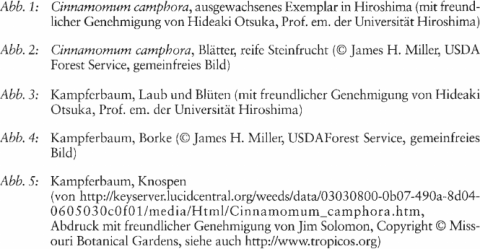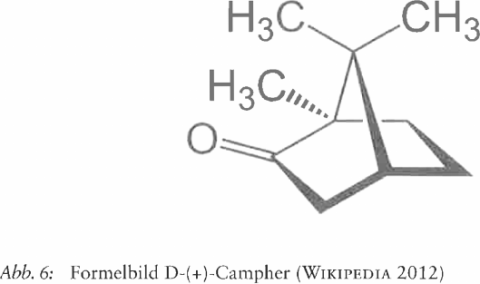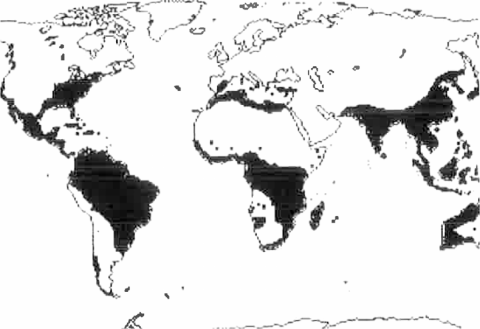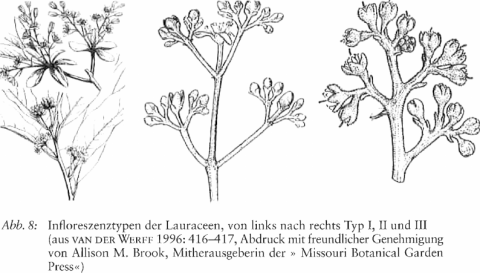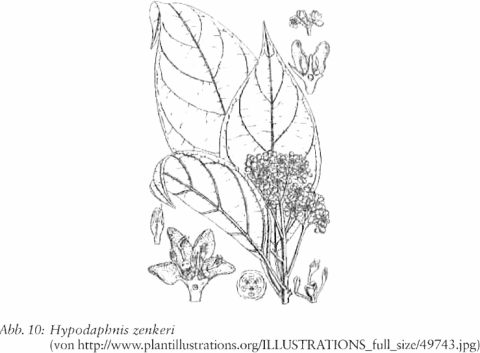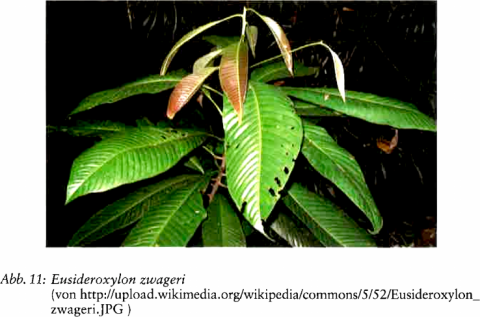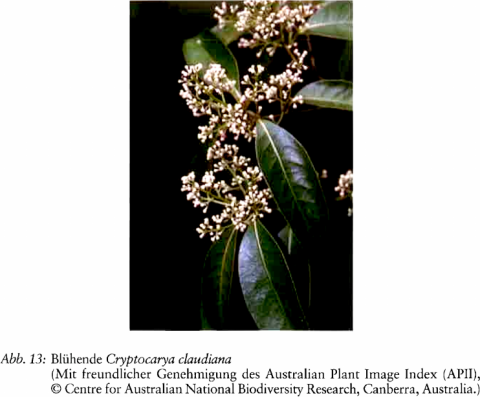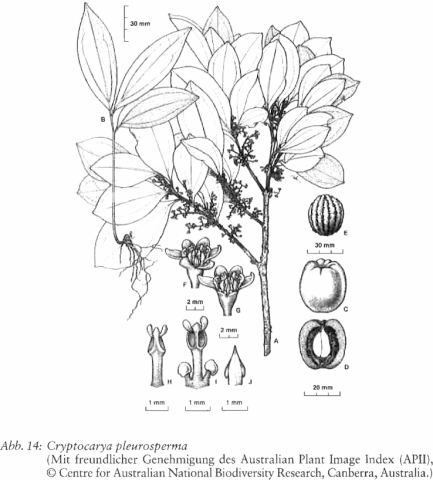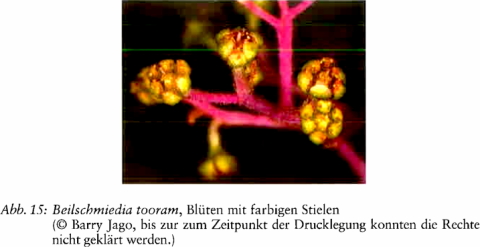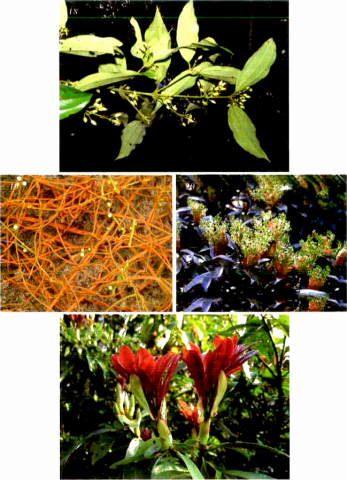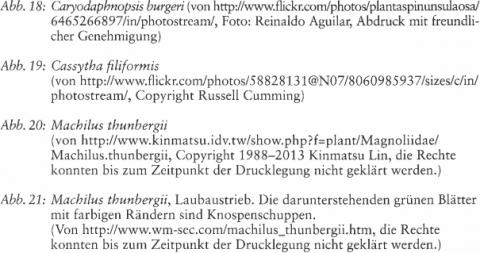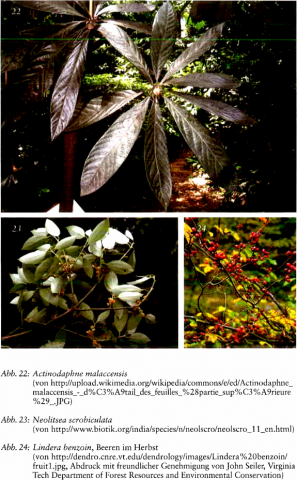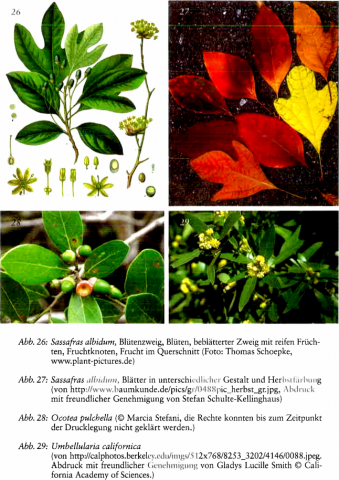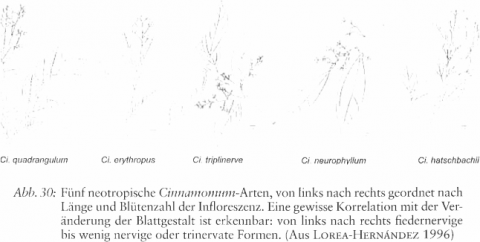Der Kampferbaum und die Lauraceen
Jahrbuch für Goetheanismus 2013, 2013,
P.209-286 |
DOI: 10.18756/jfg.2013.209
Botanik | Language: German | €6
ARTIKELREFERENZ EXPORTIEREN
- Downloadkosten : €6
Zusammenfassung:
Referenzen
- APG III : Stevens PF (2001 ff.): Angiosperm Phylogeny Website. Version 12.7.2012, Adresse: httpz//WWW.m0bot.org/MOBOT/research/APweb/
- AXELROD, D. I. (1975 ): Evolution and biogeography of Madrean—Tethyan sclerophyll vegetation. Ann. Missouri. Bot. Garden 62: 280-334
- BAY, An Herb Society of America Guide, httpz//www.herbsociety.org/factsheets/Bay% Guide.pdf, 2009
- BELZ, G. G., BREITHAUPT-GRÖGLER, K. & al. (2000): Klinische Pharmakologie von D—Campher, in: Rietbrock (Hrsg.): Phytopharmaka VI: Forschung und klinische Anwendung: 21- 28
- BERGSTEN, J. (2005): A review of long—branch attraction. Cladistics 21 (2): 163—193
- CASTRO, R. D., LIMA, E. O. (2011): Antifungal activity of Brazilian sassafras ( Ocotea odorifera Vell.) and rosemary (Rosmarinus officinalis L.) essential oils against the genus Candida. Rev. linie. Plantas Merl. 13(2): 203-208, Adresse: httpz//www.scielo.br/scielo.php? pn.l=ß ! 5 I 6—05722‘ ll | U(102000128(script:sci_ahstract
- CHAMBERS, J. (1998-2009): Laurels, »Walnuts«‚ Family Iauraceae, in: Chambers Wildlife Rain— forest Lodges, Adresse: http://rainforest—australia.com/walnuts.htm
- CHANDERBALI, A. S. &. al. (2001): Phylogeny and historical biogeography of Iauraceae: Evidence from the ch]oroplast and nuclear genomes. Ann. Missouri Bot. Garden 88(1): 104-134
- DANIEL, M. (2009): Taxonomy: Evolution at Work. Alpha Science International Ltd., Oxford
- DE WET, H. (2008): An ethnobotanical and chemotaxonornic study of South African Menispermaceae. Diss.
- DRAKE, M. E., STUHR, E. T. (1935): Some pharmacological and bactericidal properties of Umbellulone, J. Am. Pharm. Assoc. 24(3): 196-207
- ENDRESS, P. K. (2011): Evolutionary diversification of the flowers in angiosperms, Am. . of Bot. 98(3): 370-396
- ENGLER, A. (1964): Syllabus der Pflanzenfamilien, Bd. II. Gebr. Borntraeger Verl., Berlin
- FENG, ZHANG CHAO &. al. (2003): One New A—type Proanthocyanidin Trimer from Lindera aggregata. Chinese Chemical Letters '14(10): 1033-1036
- FRANKE, W. (2007): Nutzpflanzenkunde (von R. Lieberei & Chr. Reisrlorff bearbeitete 7. Aufl.). Thieme Verl., Stuttgart.
- FRANZ, G., HEMPEL, B. (2000): »Campher, ein festes ätherisches Öl«. In: Rietbrock, N. (Hrsg.): Phytopharmaka IV. Forschung und klinische Anwendung, S. 13-20. Verl. Steinkopf, Darmstadt
- FRIIS, I., PALSLEV, H. (Hrsg.) (2005 ): Plant Diversity and Complexity Patterns: Local, Regional and Global Dimensions (Kongressbericht Kopenhagen 25 .-28.5.2003)
- FRIZZO, C. D. & al. (2000): Essential oils of camphor tree cultivated in Southern Brazil. Braz. Arch. Biol. Technol. 43(3)
- FROHNE, D., JENSEN, U. (1994): Systematik des Pflanzenteichs unter besonderer Berücksichtigung chemischer Merkmale und pflanzlicher: Drogen (4. Aufl.). G. Fischer, Stuttgart u. a.
- GÄDEKE, M. (2011): Peripherie und Zentrum - Indizien für Umstülpungen im Pflanzenwachstum. Tycho de Brahe-Jahrbuch für Goetheanismus 2011: 91-148. Niefern-Öschelbronn
- GÖBEL, T. (1988): Die Pflanzenidee als Organon. Tycho de Brahe Verlag. Niefern-Öschelbronn
- GREEN, A. (2006): Field Guide to Herbs & Spices. Quirk Books, Philadelphia
- GROTH, K. (2003): Molekularsystematische Untersuchungen an der Gattung Cinnamomum Schaeffer (Lauraceae). Diplomarbeit Universität Hamburg
- HALLÉ, F., OLDEMAN, R. A. A., TOMLINSON, P. B. (1978): Tropical Trees and Forests. An Architectural Analysm. Springer Verlag, Berlin u. a.
- HEGNAUER, R. (1966): Chemataxonomie der Pflanzen, Bd. IV (Lauraceae), S. 350-381. Birkhäusur Verlag, Basel
- HEINIGKE, C. (1922): Handbuch der homöopathischen Arzneiwirkungslehre, Wilmar Schwabe (3. Aufl.). Leipzig
- HEMPEL, B. (2000): Toxikologie von D-Campher. In: Rietbrock (Hrsg.), Phytopharmaka VI (Forschung und klinischeAnwendung)‚ S. 29-37
- HENDERSON, L. (2001): Alien Weeds and Invasive Plants. Plant Protection Research Institute Handbook 12. Agricultural Research Council, Pretoria
- HENRIETTE'S HERBAL HOMEPAGE, Camphora. Kampfer. Lauraceae:
- HEO, K. & al. (1998): Embryology and relationships of Lauraceae (Laurales). Botanical journal of the Linnean Society 126(4): 295-322
- HESSE, M. (2000): Alkaloide — Fluch oder Segen der Natur?, S. 64. VCH Wiley, Weinheim
- HOFFMANN, J. J. & al. (1978): Cryptopleurine cytotoxic agent from Boehmeria caudata Urticaceae and Cryptocarya laevigata Lauraceae. Phytochemistry (Oxford) 17(8): 1448
- IANNI, A., WALDVOGEL, S. R. (2006): Reliable and versatile synthesis of 2-aryl-substituted cinnamie acid esters. Synthesis 13: 2103-2112
- JOHNS, S. R. & al. (1978): Cassytha alkaloids. II. Alkaloids of Cassytha pubescens. Australian Journal of Chemistry 19(12): 2331-2338
- KALISCH, M. (1996): Versuch einer Typologie der Substanzbildung. In: Goedings, P. (Hrsg.), Wege zur Erkenntnis der Heilpflanzen. Schriftenreihe Menchenwesen und Heilkunst, S. 110-151. Stuttgart
- KALISCH, M. (1998): Das Böse — Polarität und Steigerung. Vier Stufen der Erkenntnis, 5. Kapitel. Verlag Freies Geistesleben, Stuttgart
- KALISCH, M. (2009): Werkstattgeheimnisse der Pflanzenrnetamorphose: Aus welchem vegetativen » Material« stammen Blütenhülle und Frucht? Elemente der Naturwissenschaft 90: 140-158
- KALISCH, M. (2013a): Wie hängen Form und Stoff in der Pflanze zusammen? Zum Verständnis pflanzlicher »Inhaltsstoffe«. Der Merkusrstab 66: 47-57
- KALISCH, M. (2013b): Die Brechnuss (Strychnos nux-vomica) Ein Beispiel für die Beziehung zwischen Gestalt und Giftbildung. Der Merkurstab 66(2): 159-165
- KALISCH, M. (2013c): Die Lauraceen und der Kampferbaum-ein Entwurf (pdf), auf der Homepage von Bellis, Arbeitsgemeinschaft für goetheanistische Pflanzenerkenntnis
- KENT, J. T. (2009): Homöopatische Arzneimittelbilder. Vorlesung zur homöopatischen Materia medica (2. Aufl). Haug Verl., Stuttgart
- KERRIGAN, R. A., DIXON, D. J. (2011): Lauraceae. In: Short & al. (Hrsg.), Flora of the Darwin Region, Bd. 1, pp. 1-10.
- KOSTERMANS, A. J. G. H. (1957): Lauraceae. Reinwardtia 4(2): 193-256
- KOSTERMANS, A. J. G. H. (1964): Bibliographia Lauracearum. Min. of Natural Resources, Djakarta
- KREEB, K. H. (1983): Vegetationskunde. E. Ulmer Verl. Stuttgart
- KUMMER, K. -R (2007): Oleum camphoratum Amp. (WALA) — ein höchst nützliches Fossil. Der Merkurstab 60(3 ). 242-243
- LAHLOU, S. & al. (2005 ): Cardiovascular effects of the essential oil of Aniba canelilla bark in normotensive rats. J. Cardiovasc. Pharmacol. 46(4): 412-421
- LALOO, D. & al. (2012): Pharmocognostical and phytochemical evaluation of Cinnamomum wightii Meissn. flowers. Indian]. Nat. Products and Resources 3(1): 33-39
- LI, J. & al. (2008): Phylogenetic relationships in the Litsea complex and core Laureae (Lauraceae) using ITS and ETS sequences and morphology. Ann. Missouri Bot. Card. 95: 580-599
- LIN, C. T. & al. (2007): Bioactivity Investigation of Lauraceae Trees Grown in Taiwan. Pharmac. Biol. 45(8): 638-644
- LIU, H. (2008): 11. Neocinnamomum Laurac. Chine & Indochine, 82, 86. 1932 Flora of China 7: 187-189
- LOREA-HERNÁNDEZ, F. G. (1996): A systematic rcvision of the m-utropical species of Cinnamnmtnn Schaeffer (Lauraceae). Dissertation Universität von Missouri
- MADAUS, G. (1938): Lehrbuch der biologischen Heilmittel. Thieme Verlag, Leipzig
- MEYER, U. (2009): » Tau des Meeres « — Rosmarinus officinalis als Heilpflanze. Der Merkurstab 62(5): 455-469
- MORAES, P. L. R. de (2007): Taxonomy of Cryptocarya Species of Brazil. Royal Belgian Institute of Natural Sciences
- MOREIRA, A. C. P. & al. (2007): Inhibitory effect of Cinnamomum zeylanicum Blume (Lauraceae) essential oil and b-pinene on the growth of dematiaceous moulds. Braz. ). Microbiol. 38(1): 33-38
- MORENO, S. R. F. (2007): The ingestion of a Nectandra membranacea extract changes the biovitability of technetium 99m radiobiocomplex in rat organs. Biol. Res. 40: 131-135
- NIE, Z.-L. & al. (2007): Phylogeny and biogeography of Sassafras (Lauraceae) disjunct between eastern Asia and eastern North America. Plant Systematics and Evolution 267(1-4): 191-203
- ORWA & aI. (2009): Agroforestry Database 4.0
- PEATTIE, D. C. (1953): A natural history of western trees. Houghton Mifflin Co., Boston
- PICKERING, J. (2011): Lindera strychnifolia, Japanese Evergreen Spicebush
- RAHMAN, P. & al. (1988): Cytotoxic and antimicrobial activities of alkaloids from Dehaasia kurzii King stem bark. Bangladesh J. of Botany (1): 25-31
- RAVINDRAN, P. N. (Hrsg.) (2004): Cinnamom and Cassia. The Genus Cinnamornum. CRC Press Boca Raton, London u. a.
- RICHTER, H. G. (1981): Anatomie des sekundären Xylerns und der Rinde der Lauraceae. Zu: Sonderhiinde des Naturwissenschaftlichen Vereins in Hamburg Nr. 5. Parey Verlag, Hamburg
- ROHWER, J. G. (20003): Toward a phylogenetic classification of the Lauraceae: Evidence from matK sequenccs. Syst. Bot. 25: 60-71
- ROHWER, J. G. (2000b): Pflanzen der Tropen. BLV Verlags-GmbH, München, Wien, Zürich
- ROHWER, J. G. & al. (2009): Is Persea (Lauraceae) monophyletic? Evidence from nuclear ribosomal ITS sequences. Taxon 58: 1153-1167
- ROHWER, J. G., RICHTER, H. G., VAN DER WEREE, H. (1991): Two new genera of neotropical Lauraceae and critical remarks on the generic delimitation. Ann. Missouri Bot. Gard. 78: 388-400
- ROHWER, J. G., RUDOLPH, B. (3.005): Jumping genera: Thu phylogenetic positions of Cassytha‚ Hypodaphnis, and eocinnamomum (Lauraceae) based on different analyses of trnK intron sequences. Ann. Missouri Bot. Card. 92: 153-178
- ROTH, L., DAUNDERER, M., KORMANN, K. (1994): Giftpflanzen — Pflanzengifte (4. Aufl.). Nikol Verlagsgesellsch., Hamburg
- SCHANDRY, R. & al. (2011): Die Wirkung eines D-Campher- und Crataegus—haltigen Phytopharmakons auf den Blutdruck und die mentale Leistung bei älteren norrnotonen Frauen. Z. Phytother. 32(1): 7-10
- SCHÜTT, P., WEISGERBER, H. & al. (2004): Bäume der Tropen. Nikol Verlagsgesellsch., Hamburg
- SCHWESER, TH. (2007): Camphora - Lost in Space. Homoeopathia viva J.
- SHUKLA, N. & al. (2010): Tectone, a new antihyperglycemic anthraquinone from Tectona grandis leaves. Nat. Prod. Commun. 5(3): 427-430
- STEINEGGER, E., HÄNSEL, R. (1988): Lehrbuch der Pharmakognosie und Phytopharmazie (4. Aufl.). Springer. Berlin u. a.
- STEINER, R. (1884): Einleitungen zu Goethes naturwissenschaftlichen Schriften (GA 1), S. 126. Dornach (1987):
- STEINER, R. (1906): Kosmogonie (GA 94) Vortr. vom 3.11.1906. Dornach
- STEINER, R. (1907): Menschheitsentwickelung und Christus-Erkenntnis (GA 100), Vortr. vom 24.6.1907. Dornach
- STEINER, R. (1908a): Geisteswissenschaftliche Menschenkunde (GA 107). Dornach
- STEINER, R. (1908b): Die Beantwortung von Welt- und Lebensfragen durch Anthroposophie (GA 1108). Dornach
- STEINER, R. (1917): Menschliche und rnenschheitliche Entwicklungswahrheiten. Das Karma des Materialismus (GA 176), Vortr. vom 17.7.1917. Dornach
- STEINER, R. (1919): Erziehungskunst. Seminarbesprechungen und Lehrplanvorträge (GA 295), 9. Seminarbesprechung, 30.8.1919. Dornach
- STEINER, R. (1920): Geisteswissenschaft und Medizin (GA 312), Vortr. vom 25.3.1920. Dornach
- STEINER, R. (1921a): Anthroposophie als Kosmosophie II (GA 208), Vortr. vom 5.11.1921. Dornach
- STEINER, R. (1921b): Geisteswissenschaftliche Gesichtspunkte zur Therapie (GA 313), Vortr. vom 12./13.4.1921. Dornach
- STEINER, R. (1922): Menschenfragen und Weltenantworten (GA 213), Vortr. vom 2.7.1922. Dornach
- STEINER, R. (1923): Die Impulsierung des weltgeschichtlichen Geschehens durch geistige Mächte (GA 222). Vortr. vom 22.3.1923. Dornach
- STEINER, R. (1924a): Physiologisch-Therapeutisches auf Grundlage der Geisteswissenschaft (GA 314), Vortr. vom 2.1.1924, 21.4.1924. Dornach
- STEINER, R. (1924b): Geisteswissenschaftliche Grundlagen zum Gedeihen der Landwirtschaft (GA 327), Vortr. vom 11.6.1924. Dornach
- STEINER, R. (1924c): Heilpädagogischer Kurs (GA 317), Vortr: vom 27.6.1924. Dornach
- SUH, W. M. & al. (2011): Suppression of mast-cell-mediated allergic inflammation by Lindera obtusiloba. Exp. Biol. Med. (Maywood) 236(2): 240-246
- TROLL, W. (1967, autoris. Nachdruck von 1030): Vergleichende Morphologie der höheren Pflanzen, Teil I/2: 1082 ff.
- URANIA-Pflanzenreich (1991): Blütenpflanzen, Bd. I und II (1. Aufl. 1993). Leipzig, Jena (Ausg. 1991)
- VAN DER WERFF, H., RICHTER, J. G. (1996): Toward an improved classification of Lauraceae. Annals of the Missouri Botanical Garden 83(3): 409-418
- VARESCHI, V. (1980): Vegetationsökologie der Tropen. E. Ulmer Verl., Stuttgart
- VAUGHAN, J. G., GEISSLER, C. (2009): The New Oxford Book of Food Plants. Oxford University Press
- WALTER, H., BRECKLE, S.-W. (1991): Ökologie der Erde, Bd. 4 (Spezielle Ökologie der gemäßigten und arktischen Zonen außerhalb Euro-Nordasien), S. 231-292. (UTB: Große Reihe). VErl. G. Fischer, Stuttgart
- WANG, Z. H. & al. (2010): Phylogeny of the Southeast Asian endemic genus Neocinnamomum H. Liu (Lauracmc). Plant Hyatt-maria and Evolution 291(1):173-184
- WANSI, S. L. & al. (2007): Blond pressure lowering effect of the ethanol extract from the stembark of Cinnamomum zeylanicum (Lauraceae) in rats. Pharmacology online 3: 166-176
- WATSON, L., DALLWITZ, M. J. (1992 ff.): The Families of Flowering Plants: Descriptions, Illustrations, Identification, and Information Retrieval. Version: 28th May 1999. http:// biodiversity.uno.edufdelta/
- WEBER, H.-Chr. (1993): Parasitismus von Blütenpflanzen, S. 12 ff. WBG, Darmstadt
- WEBERLING, F. (1989): Morphology of Flowers and Inflorescences. Cambridge Univ. Press
- WEBSTER'S Revised Unabridged Dictionary (1913): G & C. Merriam Co., Noah Porter (Hrsg.)
- WIKIPEDIA (2012): Lorbeergewächse, Stand 7.5.2012. httpz//de.wikipedia.org/wiki/Lorbeergew% C3 %A4chse
- WIKIPEDIA (2012): deutsche Version (Mai 2012): Lauraceae: englische und spanische Seite
- XIAOMING YANG & al. (2011): Antitumor Agents 288: Design, Synthesis, SAR, and Biological Studies of Novel Heteroatom—Incorporated Antofine and Cryptopleurine Analogues as Potent and Selective Antitumor Agents. J. Med. Chem. 54: 5097-5107
- XI-WEN Li, jIE LI, VAN DER WERFF, H. (2008): Flora of China (FOC) 7, S. 102, 103, 105, 113, 1.66, Lauraceae, 10. Cinnamomum Schaeffer. Bot. Exped. 74: 1760, Adresse http:// www.efloras.orgjflorataxon.aspx?flora_id=28ctaxon_id=107109#KEY-1-14
- ZHENG HAN & al. (2008): Simultaneous determination of four alkaloids in Lindera aggregata. Journal of Chromatography A 1212(1-2): 76-81
- ZHU , M. & al. (1998): Cytoprotective effect of Lindera aggregata roots against ethanol—induced acute gastric injury. Pharmaceutical Biology 36: 2222-2226


